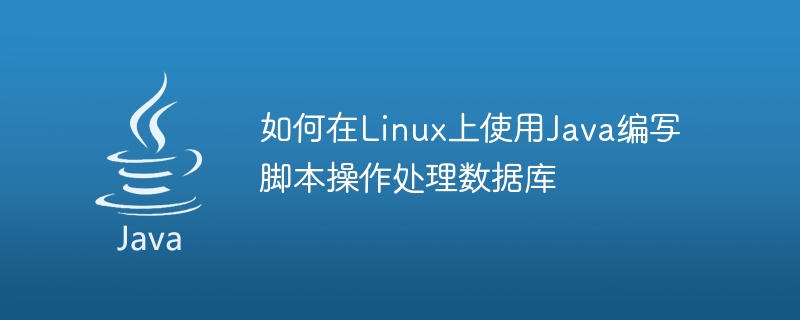

How to use Java to write scripts to operate and process databases on Linux
On the Linux operating system, using Java to write scripts to operate and process databases is a common and powerful method. Way. As an object-oriented programming language, Java has a rich database operation API and tool library, which can easily connect to the database, execute SQL statements and process query results.
The following will introduce how to use Java to write scripts on Linux to operate and process the database. We take the MySQL database as an example, because MySQL is a commonly used database and is also a database that is well integrated with Java.
First, we need to install the Java development environment and MySQL database. On Linux, you can use package management tools such as apt-get or yum to install Java and MySQL. After the installation is complete, we need to ensure that the environment variables for Java and MySQL are configured correctly.
Next, we can create a Java class in which to implement the functions of database connection, executing SQL and processing query results. The following is a simple example that demonstrates how to use Java to write a script to connect to a MySQL database, query data and output the results.
import java.sql.*; public class DatabaseScript { // 定义数据库连接参数 private static final String DB_URL = "jdbc:mysql://localhost:3306/mydatabase"; private static final String USER = "username"; private static final String PASSWORD = "password"; public static void main(String[] args) { Connection conn = null; Statement stmt = null; try { // 创建数据库连接 conn = DriverManager.getConnection(DB_URL, USER, PASSWORD); // 创建Statement对象 stmt = conn.createStatement(); // 执行SQL语句 String sql = "SELECT * FROM mytable"; ResultSet rs = stmt.executeQuery(sql); // 处理查询结果 while (rs.next()) { int id = rs.getInt("id"); String name = rs.getString("name"); int age = rs.getInt("age"); System.out.println("id: " + id + ", name: " + name + ", age: " + age); } // 关闭查询结果集,Statement和连接 rs.close(); stmt.close(); conn.close(); } catch (SQLException se) { se.printStackTrace(); } finally { // 关闭Statement和连接 try { if (stmt != null) { stmt.close(); } } catch (SQLException se2) { } try { if (conn != null) { conn.close(); } } catch (SQLException se) { se.printStackTrace(); } } } }
In the above code, we use Java's JDBC API to connect to the MySQL database. First, we create a database connection object through theDriverManager.getConnection()method. Then, use the connection object to create a Statement object for executing SQL statements. Next, execute the SQL statement and obtain the query results through the ResultSet. Finally, close the result set, Statement and connection.
The above code can be compiled into an executable binary file through the javac command. Then, use the java command to execute this script file. The execution results will be output on the terminal.
Through the above examples, we can see that using Java to write scripts on Linux is a simple and powerful way to operate and process databases. Using Java's JDBC API, we can easily connect to the database, execute SQL statements and process query results. In this way, we can enjoy the powerful functions of Java and the freedom and flexibility of the Linux operating system on Linux at the same time.
The above is the detailed content of How to script database operations using Java on Linux. For more information, please follow other related articles on the PHP Chinese website!
